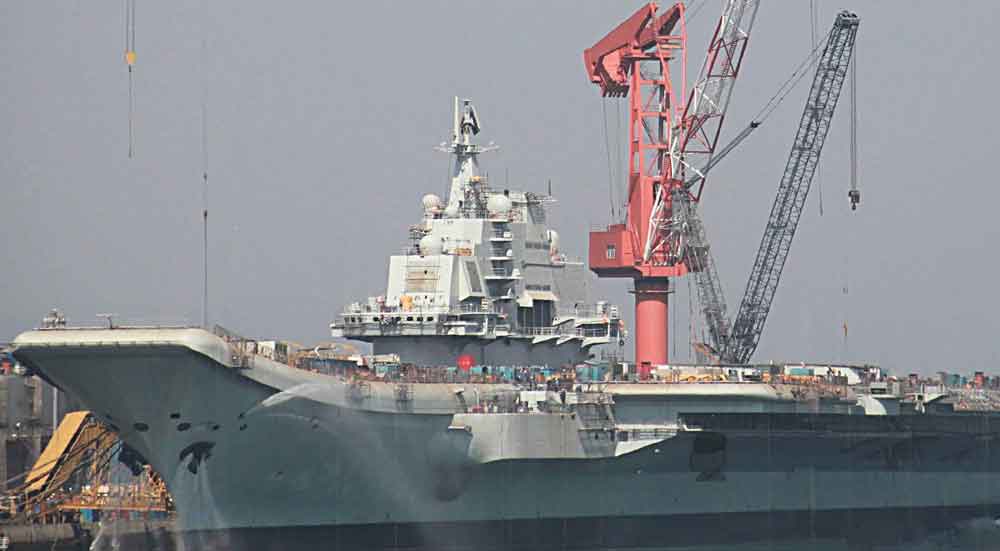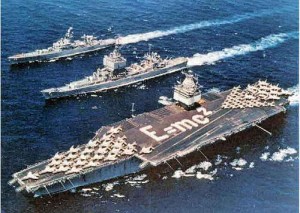In the second step, the PLAN aimed to develop a regional naval force that can operate beyond the first island chain to reach the second island ring which includes Guam, Indonesia, and Australia. In the third-stage, the PLAN will develop a global naval force by the mid twenty-first century. They have also invested heavily in maritime infrastructure. The port cities of Dalian, Dongjiakou and Majishan can now handle Valemaxes with cargo of 400,000 MT each.
Though the Chinese were earlier entirely dependent on imported military design and technology, they have, within a span of fifty years, steadily reduced their imports whilst their own military technology has continued to expand rapidly using their indigenous design signature. They are now extremely strong in reverse engineering using manufacturing processes of their own.
The lesson from Britain is very pertinent because it shows how it was feasible under good leadership and rapid industrialization to make the transition from an agricultural society to an industrial one and then maintain leadership for a very long time.
Consequently, their offshore shopping basket may soon be only limited to very expensive, single order state-of-art weapons/weapon systems. It can be safely assumed that they will be entirely self-reliant in arms and space technology within the next decade or so. Fig. 6 shows their latest fleet addition, the refurbished Aircraft Carrier at its fitting out berth just prior to sea trials.
United Kingdom
The Royal Navy, founded in the sixteenth century, maintained its leadership and was the largest navy in the world through the eighteenth and nineteenth century maintaining its ascendancy over every rival with the quality of its fighting machines. In the twentieth century, it had successfully fought two World Wars during which it still showed its innovative capabilities in terms of communications, radar, jet engines, Asdic and armaments. Even though the United Kingdom has downsized its navy in the post War period, it still maintained the leadership role in warship design, armament, communication and propulsion both conventional and nuclear.
The lesson from Britain is very pertinent because it shows how it was feasible under good leadership and rapid industrialization to make the transition from an agricultural society to an industrial one and then maintain leadership for a very long time.
United States of America
As a result of the War of Independence, the US developed its own design and production capacity and resolutely maintained military supremacy thereafter. The US Navy saw little action during World War I, but nevertheless its strength grew under an ambitious ship building program associated with the Naval Act of 1916. The US Navy grew into a formidable force in the years prior to World War II, with battleship production being revived in 1937, commencing with the USS North Carolina. Though ultimately unsuccessful, Japan attempted to counter this strategic threat with the 1941 surprise attack on Pearl Harbour.
Following American entry into the war, the US Navy grew tremendously as the country was faced with maritime threats on two fronts. By 1943, the Navy’s size was larger than the combined fleets of all the other combatant nations in World
War II. By the war end of the 1945, the United States Navy had added hundreds of new ships, including 18 aircraft carriers and 8 battleships and had over 70 percent of the world’s total number and total tonnage of naval vessels of 1,000 tons or greater. At its peak, in August 1945, the USN was operating 6,768 ships.
Even terrorists with the minimum of regular R&D and field trials have shown that they too can easily acquire, improvise and adapt…
Although prior to 1940, the USN had followed in the footsteps of the navies of Great Britain and Germany which favoured concentrated groups of battleships as their main offensive naval weapons, it was extremely quick to change. The development of the aircraft carrier and its devastating utilization by the Japanese at Pearl Harbour led to a profound change in its strategy and led to the development of the carrier battle group. The Pearl Harbour attack destroyed or took out of action a significant number of USN battleships and placed much of the burden of retaliation against the Japanese on the small number of aircraft carriers. In the post War period, the USN continued its technological advancement by leapfrog development of new weapons systems, ships, aircraft and nuclear submarines.
Many consider the global blue water Nuclear Carrier group of the USN complete with its vast array of logistic vessels as the gold standard. The US in 1944, rose to the challenges of the World War and has since then, become the dominant leader in arms supply and design. The US Navy now has the largest fleet in the world. Its battle fleet and auxiliary tonnage is greater than that of the next thirteen largest navies combined. The US Navy also has the world’s largest carrier fleet, with eleven in service, one under construction (two planned), and one in reserve. It operates 286 ships in active service and more than 3,700 aircraft. The US experience shows that a period of sixty years of prosperity is quite adequate for a country to reach a leadership role. Figs. 7 and 8 show one of carrier groups and the latest ballistic missile submarine of the US Navy.
Owing to the advancements information technology, nations now quickly discover their relative shortcomings and race to close the gap. Even terrorists with the minimum of regular R&D and field trials have shown that they too can easily acquire, improvise and adapt to opposing military technology and even develop inexpensive impromptu counter measures of their own designs.
Their technicians are extremely innovative. They adapt and deliver within months not decades. As global trade and communication improve, it would be fair to assume that the current period of sixty years to attain leadership will in future steadily shrink.
A nation must clearly define its mandate by seeking one of the three motivations that historically nations have used to seek leadership roles in military technology. These motivations though kept secret from public are explicit and precise with desired outcomes. The first, motivation is the “pursuit of wealth” which is connected to economics and structured by economic history. The second alternative is the distinct “pursuit of power” which results in influencing international relations by implicit display of military muscle. The third motivation is the declared aspiration of a “victory in war” against an identified and more advanced adversary. These motivations are then translated into concrete plans with strict time lines, accountability and budgets. They are not open-ended, unending five-year plans with little or no accountability.
A good designer uses both hemispheres of his brain. The left hemisphere is the one connected to memory and analysis. The right hemisphere is linked to creativity and the ability to compose, write and draw.
Each of these motivations, well intended as they may appear initially, are affected by time. In the short haul, governments which are dictatorial or autocratic are able to maintain either the “pursuit of power” or the aspiration of a “victory in war” for a long time ignoring any economic deprivations that their population has to endure. The best examples of this, was the USSR under communist leadership, Germany and Japan prior to World War II.
In democratic countries, as the tenure of governance is limited to about five years, continuity of policy beyond that period is dependent on a host of other factors which may include governance by coalition consensus, economic downturns, political defections and corruption. Continuation of an earlier prescribed motivation is then far more difficult. However, first the UK and then the USA, have shown that with decades of prosperity, good governance and economic growth, it is feasible for a democratic country to achieve and maintain that exclusive leadership role for a very long time.
The “pursuit of wealth” simply defines the commercial and economic forces that prevail in the production and distribution of military goods between nations who are the buyers and sellers. It assumes that the required state of industrialisation exists, together with an adequate infrastructure, skilled force, raw materials and transport. In brief, it is motivated by assessing if the venture is feasible and profitable, markets and finance exists and that law and order is reliable. The European Countries and Israel mentioned earlier have chosen to be very good military hardware suppliers motivated by commercial profit. The arms industry has always been a catalyst for industrial progress since it consistently leads to higher GDP.
The “pursuit of power” referred to defines the minimum needs that a state must display to exert a definite influence on surrounding neighbours and potential adversaries. The arms market is a direct result of certain states importing their requirements which they cannot manufacture by themselves. Logically, every state would, if they could, produce arms. The uneven distribution of social, economic and technical skills amongst nations implies that there will always be some who do not have the capacity to produce arms and have to rely on external sources. Nevertheless, the “pursuit of power” requires the nation to delineate its sphere of influence and then assess its arms requirements to maintain that relationship.
War is the engine that propels history. As a motivation factor, it provides the greatest incentive to the nation to be self-sufficient in the arms it needs to be victorious. The pursuit of “victory in war” generates tremendous enthusiasm for innovation, high levels of productivity, better quality control and improvements in the supply chain on a total system basis. As shown by the experiences of the allies in World War II, it was possible to leapfrog interim phases of development and design and build the most advanced arms even though the economic and technological capacity of the nation could not have sustained it in peace time. Technology often gets tremendous boost since technical innovation and high levels of production are an intrinsic requirement of any war machine.








India has been languishing at level 3 for decades while our import dependence has been to the extent of 70% instead of being near zero as ought to be. Main reason is nexus & power of the arms lobby wields all over. There are many examples- for decades MBT Arjun had been at the receiving end of media campaign, successful production lines of a successfully indigenised rocket system was halted midway,local development of 155 mm guns was not allowed inspite of its production drawings being with us for two decades, Tatra way shows how it all works at every level. A nation which can put a ballistic miles on the dot 5000 km away surely can make ordinary bombs,tanks, trucks too provided there is more of pride & less of prejudice.
Now that we are realizing the worth of indigenous with economic slow down & corruption being a dirty word-hopefully we shall migrate to level 4 slowly but steadily.